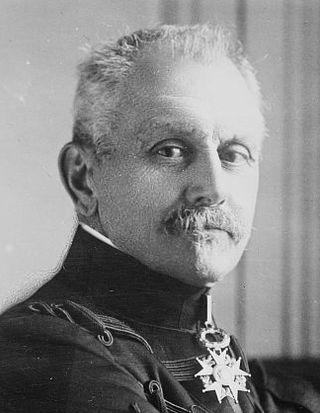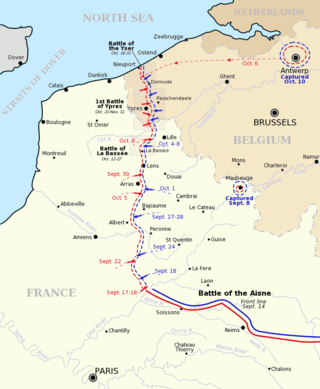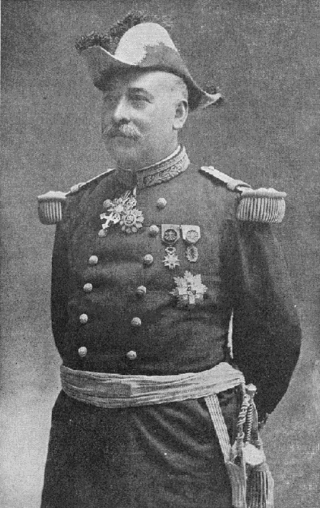
The First Battle of the Marne was a battle of the First World War fought from 5 to 12 September 1914. The German army invaded France with a plan for winning the war in 40 days by occupying Paris and destroying the French and British armies (Allies/Entente). The Germans had initial successes in August. They were victorious in the Battles of Mons and the Frontiers and overran a large area of northern France and Belgium. In what is called the Great Retreat the Germans pursued the retreating Franco/British forces more than 250 km (160 mi) southward. The French and British halted their retreat in the Marne River valley while the Germans advanced to 40 km (25 mi) from Paris.

Joseph Jacques Césaire Joffre, was a French general who served as Commander-in-Chief of French forces on the Western Front from the start of World War I until the end of 1916. He is best known for regrouping the retreating allied armies to defeat the Germans at the strategically decisive First Battle of the Marne in September 1914.

The Battle of the Ardennes took place during the First World War fought on the frontiers of France, Germany, Belgium and Luxembourg from 21 to 23 August 1914. The German armies defeated the French and forced their retreat. The battle was part of the larger Battle of the Frontiers, the first battle of the Western Front.

The Battle of Mons was the first major action of the British Expeditionary Force (BEF) in the First World War. It was a subsidiary action of the Battle of the Frontiers, in which the Allies clashed with Germany on the French borders. At Mons, the British Army attempted to hold the line of the Mons–Condé Canal against the advancing German 1st Army. Although the British fought well and inflicted disproportionate casualties on the numerically superior Germans, they were eventually forced to retreat due both to the greater strength of the Germans and the sudden retreat of the French Fifth Army, which exposed the British right flank. Though initially planned as a simple tactical withdrawal and executed in good order, the British retreat from Mons lasted for two weeks and took the BEF to the outskirts of Paris before it counter-attacked in concert with the French, at the Battle of the Marne.

Alexander Heinrich Rudolph von Kluck was a German general during World War I.

The Race to the Sea took place from about 17 September – 19 October 1914 during the First World War, after the Battle of the Frontiers and the German advance into France. The invasion had been stopped at the First Battle of the Marne (5–12 September) and was followed by the First Battle of the Aisne (13–28 September), a Franco-British counter-offensive. The term describes reciprocal attempts by the Franco-British and German armies to envelop the northern flank of the opposing army through the provinces of Picardy, Artois and Flanders, rather than an attempt to advance northwards to the sea. The "race" ended on the North Sea coast of Belgium around 19 October, when the last open area from Diksmuide to the North Sea was occupied by Belgian troops who had retreated after the Siege of Antwerp. The outflanking attempts had resulted in a number of encounter battles but neither side was able to gain a decisive victory.

Plan XVII was the name of a "scheme of mobilization and concentration" that was adopted by the French Conseil Supérieur de la Guerre from 1912 to 1914, to be put into effect by the French Army in a war between France and Germany. It was a plan for the mobilisation, concentration and deployment of the French armies, to make possible an invasion of either Germany or Belgium or both, before Germany completed the mobilisation of its reserves simultaneous with a Russian offensive.

The Battle of the Frontiers comprised battles fought along the eastern frontier of France and in southern Belgium, shortly after the outbreak of the First World War. The battles resolved the military strategies of the French Chief of Staff General Joseph Joffre with Plan XVII and an offensive adaptation of the German Aufmarsch II deployment plan by Helmuth von Moltke the Younger. The German concentration on the right (northern) flank, was to wheel through Belgium and attack the French in the rear.

The Battle of Mulhouse, also called the Battle of Alsace, which began on 7 August 1914, was the opening attack of the First World War by the French Army against the German Empire. The battle was part of a French attempt to recover the province of Alsace, which France had ceded to the new empire following its defeat in the Franco-Prussian War of 1870–1871. The French occupied Mulhouse on 8 August and were then forced out by German counter-attacks on 10 August. The French retired to Belfort, where General Louis Bonneau, the VII Corps commander, was sacked, along with the commander of the 8th Cavalry Division. Events further north led to the German XIV and XV corps being moved away from Belfort and a second French offensive by the French VII Corps, reinforced and renamed the French Army of Alsace, began on 14 August.

The Great Retreat, also known as the retreat from Mons, was the long withdrawal to the River Marne in August and September 1914 by the British Expeditionary Force (BEF) and the French Fifth Army. The Franco-British forces on the Western Front in the First World War had been defeated by the armies of the German Empire at the Battle of Charleroi and the Battle of Mons. A counter-offensive by the Fifth Army, with some assistance from the BEF, at the First Battle of Guise failed to end the German advance and the retreat continued over the Marne. From 5 to 12 September, the First Battle of the Marne ended the Allied retreat and forced the German armies to retire towards the Aisne River and to fight the First Battle of the Aisne (13–28 September). Reciprocal attempts to outflank the opposing armies to the north known as the Race to the Sea followed from (17 September to 17 October).

Michel-Joseph Maunoury was a commander of French forces in the early days of World War I who was posthumously elevated to the dignity of Marshal of France.

The Second Battle of the Aisne was the main part of the Nivelle Offensive, a Franco-British attempt to inflict a decisive defeat on the German armies in France. The Entente strategy was to conduct offensives from north to south, beginning with an attack by the British Expeditionary Force (BEF) then the main attack by two French army groups on the Aisne. General Robert Nivelle planned the offensive in December 1916, after he replaced Joseph Joffre as Commander-in-Chief of the French Army.

The Nivelle offensive was a Franco-British operation on the Western Front in the First World War which was named after General Robert Nivelle, the commander-in-chief of the French metropolitan armies, who led the offensive. The French part of the offensive was intended to be strategically decisive by breaking through the German defences on the Aisne front within 48 hours, with casualties expected to be around 10,000 men. A preliminary attack was to be made by the French Third Army at St Quentin and the British First, Third and Fifth armies at Arras, to capture high ground and divert German reserves from the French fronts on the Aisne and in Champagne. The main offensive was to be delivered by the French on the Chemin des Dames ridge. A subsidiary attack was to be made by the Fourth Army. The final stage of the offensive was to follow the meeting of the British and French armies, having broken through the German lines, to pursue the defeated German armies towards the German frontier.

The Battle of Lorraine was a battle on the Western Front during the First World War. The armies of France and Germany had completed their mobilisation, the French with Plan XVII, to conduct an offensive through Lorraine and Alsace into Germany and the Germans with Aufmarsch II West, for an offensive in the north through Luxembourg and Belgium into France, supplemented with attacks in the south to prevent the French from transferring troops to the greater threat in the north.

The Battle of Charleroi or the Battle of the Sambre, was fought on 21 August 1914, by the French Fifth Army and the German 2nd and 3rd armies, during the Battle of the Frontiers. The French were planning an attack across the Sambre River, when the Germans attacked first, forced back the French from the river and nearly cut off the French retreat by crossing the Meuse River around Dinant and getting behind the French right flank. The French were saved by a counter-attack at Dinant and the re-direction of the 3rd Army to the north-west in support of the 2nd Army, rather than south-west.

The Battle of Albert began on 25 September 1914, in what became known as the "Race to the Sea", during the First World War. It followed the First Battle of the Aisne as both sides moved northwards, trying to turn the northern flank of their opponent. The Second Army, began to assemble at Amiens in mid-September and was directed by General Joseph Joffre, the Generalissimo of the French Army, to attack near Albert.

Charles Lanrezac was a French general, formerly a distinguished staff college lecturer, who commanded the French Fifth Army at the outbreak of the First World War.

The Battle of Arras, was an attempt by the French Army to outflank the German Army, which was attempting to do the same thing during the "Race to the Sea", the reciprocal attempts by both sides, to exploit conditions created during the First Battle of the Aisne. At the First Battle of Picardy (22–26 September) each side had attacked expecting to advance round an open northern flank and found instead that troops had arrived from further south and extended the flank northwards.

The siege of Namur was a battle between Belgian and German forces around the fortified city of Namur during the First World War. Namur was defended by a ring of modern fortresses, known as the Fortified Position of Namur and guarded by the 4th Division of the Belgian Army. The purpose of the fortified Belgian cities was to delay an invasion force until troops from the states guaranteeing Belgian independence came to their aid. The French Fifth Army planned to counter-attack while the Germans were besieging Namur.

The First Battle of Picardy(22–26 September 1914) took place during the Race to the Sea (17 September – 19 October) and the First Battle of the Aisne (13–28 September). The "race" was a Franco-British counter-offensive, which followed the Battle of the Frontiers and the German advance into France during the Great Retreat, which ended at the First Battle of the Marne (5–12 September). The term describes reciprocal attempts by the Franco-British and German armies to envelop the northern flank of the opposing army, through Picardy, Artois and Flanders.


















